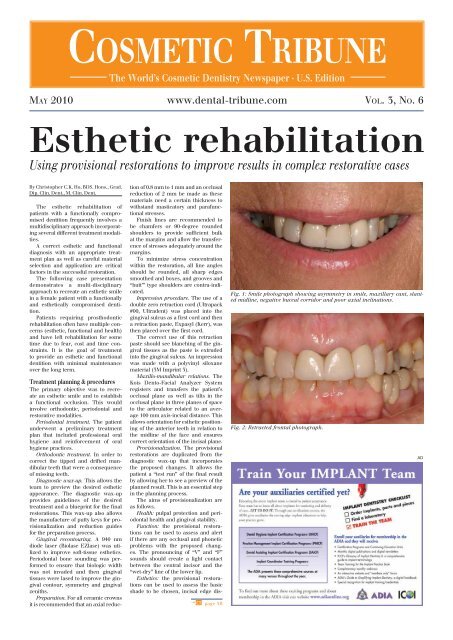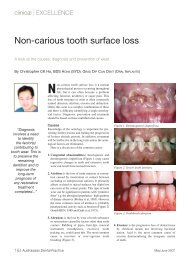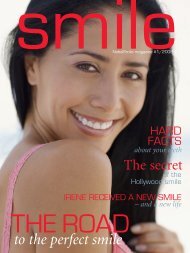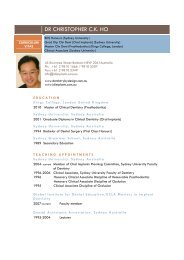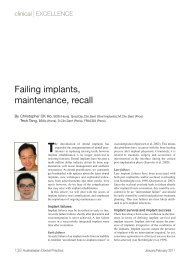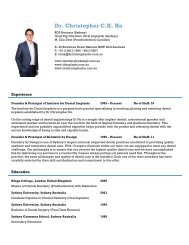Esthetic rehabilitation - Dental Implants
Esthetic rehabilitation - Dental Implants
Esthetic rehabilitation - Dental Implants
Create successful ePaper yourself
Turn your PDF publications into a flip-book with our unique Google optimized e-Paper software.
CoSMETIC TRIBUNE<br />
The World’s Cosmetic Dentistry Newspaper · U.S. Edition<br />
May 2010 www.dental-tribune.com Vol. 3, No. 6<br />
<strong>Esthetic</strong> <strong>rehabilitation</strong><br />
Using provisional restorations to improve results in complex restorative cases<br />
By Christopher C.K. Ho, BDS. Hons., Grad.<br />
Dip. Clin. Dent., M. Clin. Dent.<br />
The esthetic <strong>rehabilitation</strong> of<br />
patients with a functionally compromised<br />
dentition frequently involves a<br />
multidisciplinary approach incorporating<br />
several different treatment modalities.<br />
A correct esthetic and functional<br />
diagnosis with an appropriate treatment<br />
plan as well as careful material<br />
selection and application are critical<br />
factors in the successful restoration.<br />
The following case presentation<br />
demonstrates a multi-disciplinary<br />
approach to recreate an esthetic smile<br />
in a female patient with a functionally<br />
and esthetically compromised dentition.<br />
Patients requiring prosthodontic<br />
<strong>rehabilitation</strong> often have multiple concerns<br />
(esthetic, functional and health)<br />
and have left <strong>rehabilitation</strong> for some<br />
time due to fear, cost and time constraints.<br />
It is the goal of treatment<br />
to provide an esthetic and functional<br />
dentition with minimal maintenance<br />
over the long term.<br />
Treatment planning & procedures<br />
The primary objective was to recreate<br />
an esthetic smile and to establish<br />
a functional occlusion. This would<br />
involve orthodontic, periodontal and<br />
restorative modalities.<br />
Periodontal treatment. The patient<br />
underwent a preliminary treatment<br />
plan that included professional oral<br />
hygiene and reinforcement of oral<br />
hygiene practices.<br />
Orthodontic treatment. In order to<br />
correct the tipped and drifted mandibular<br />
teeth that were a consequence<br />
of missing teeth.<br />
Diagnostic wax-up. This allows the<br />
team to preview the desired esthetic<br />
appearance. The diagnostic wax-up<br />
provides guidelines of the desired<br />
treatment and a blueprint for the final<br />
restorations. This wax-up also allows<br />
the manufacture of putty keys for provisionalization<br />
and reduction guides<br />
for the preparation process.<br />
Gingival recontouring. A 940 nm<br />
diode laser (Biolase EZlase) was utilized<br />
to improve soft-tissue esthetics.<br />
Periodontal bone sounding was performed<br />
to ensure that biologic width<br />
was not invaded and then gingival<br />
tissues were lased to improve the gingival<br />
contour, symmetry and gingival<br />
zeniths.<br />
Preparation. For all ceramic crowns<br />
it is recommended that an axial reduc-<br />
tion of 0.8 mm to 1 mm and an occlusal<br />
reduction of 2 mm be made as these<br />
materials need a certain thickness to<br />
withstand masticatory and parafunctional<br />
stresses.<br />
Finish lines are recommended to<br />
be chamfers or 90-degree rounded<br />
shoulders to provide sufficient bulk<br />
at the margins and allow the transference<br />
of stresses adequately around the<br />
margins.<br />
To minimize stress concentration<br />
within the restoration, all line angles<br />
should be rounded, all sharp edges<br />
smoothed and boxes, and grooves and<br />
“butt’” type shoulders are contra-indicated.<br />
Impression procedure. The use of a<br />
double zero retraction cord (Ultrapack<br />
#00, Ultradent) was placed into the<br />
gingival sulcus as a first cord and then<br />
a retraction paste, Expasyl (Kerr), was<br />
then placed over the first cord.<br />
The correct use of this retraction<br />
paste should see blanching of the gingival<br />
tissues as the paste is extruded<br />
into the gingival sulcus. An impression<br />
was made with a polyvinyl siloxane<br />
material (3M Imprint 3).<br />
Maxillo-mandibular relations. The<br />
Kois Dento-Facial Analyzer System<br />
registers and transfers the patient’s<br />
occlusal plane as well as tilts in the<br />
occlusal plane in three planes of space<br />
to the articulator related to an average<br />
100 mm axis-incisal distance. This<br />
allows orientation for esthetic positioning<br />
of the anterior teeth in relation to<br />
the midline of the face and ensures<br />
correct orientation of the incisal plane.<br />
Provisionalization. The provisional<br />
restorations are duplicated from the<br />
diagnostic wax-up that incorporates<br />
the proposed changes. It allows the<br />
patient a “test run” of the final result<br />
by allowing her to see a preview of the<br />
planned result. This is an essential step<br />
in the planning process.<br />
The aims of provisionalization are<br />
as follows.<br />
Health: pulpal protection and periodontal<br />
health and gingival stability.<br />
Function: the provisional restorations<br />
can be used to assess and alert<br />
if there are any occlusal and phonetic<br />
problems with the proposed changes.<br />
The pronouncing of “V” and “F”<br />
sounds should create a light contact<br />
between the central incisor and the<br />
“wet-dry” line of the lower lip.<br />
<strong>Esthetic</strong>s: the provisional restorations<br />
can be used to assess the basic<br />
shade to be chosen, incisal edge dis-<br />
g CT page 3B<br />
Fig. 1: Smile photograph showing asymmetry in smile, maxillary cant, slanted<br />
midline, negative buccal corridor and poor axial inclinations.<br />
Fig. 2: Retracted frontal photograph.<br />
AD
2B<br />
Clinical CoSMETIC TRIBUNE | May 2010<br />
Fig. 3: Orthodontic treatment to upright tipped teeth and correct occlusal<br />
plane.<br />
Fig. 4: Gingival recontouring completed.<br />
Fig. 5: Crowns sectioned to allow insertion of Christensen crown remover for<br />
removal.<br />
Fig. 6: Use of Expasyl for hemastasis and retraction.<br />
f CT page 1B<br />
play, form and shape of teeth, dental<br />
midline location, lip support, parallelism<br />
of incisal plane to inter-pupillary<br />
line as well as the curvature of lower<br />
lip.<br />
Evaluation of esthetics provided by<br />
the provisionals at this stage is crucial<br />
in guiding the patient to the amount of<br />
display necessary for an esthetic smile.<br />
The provisional crowns were constructed<br />
with Protemp 4 (3M-ESPE), a<br />
bis-acryl resin composite. All contours<br />
were kept curvaceous and smooth with<br />
space made available for the patient to<br />
use interdental cleaning aids due to<br />
the provisionals being totally splinted<br />
together.<br />
The patient is given instructions on<br />
oral hygiene during the provisional<br />
phase and is asked to return in two to<br />
three days time for final approval.<br />
I recommend this delayed approach<br />
of assessing the provisionals as the<br />
patient is not pressured into deciding if<br />
she likes the provisionals on the day of<br />
preparation. The patient is often anesthetized<br />
with associated facial palsy<br />
and cannot adequately assess esthetics<br />
at this time.<br />
Patients will also often ask friends<br />
and family about the proposed changes<br />
and the extra time allows the patients<br />
to accustom themselves to the new<br />
“look.”<br />
If the provisional restoration<br />
requires modifications, the provisionals<br />
can be adjusted and an impression<br />
then made for communication to the<br />
ceramist of the additional changes.<br />
Cementation. The crowns are<br />
received back from the laboratory and<br />
tried in the mouth. I prefer not to<br />
use local anesthetic for the patient<br />
to approve the final esthetics before<br />
cementation.<br />
However, if local anesthesia is<br />
required, an alternative technique<br />
is to use the AMSA local anesthetic<br />
block technique so that the injection<br />
achieves pulpal anesthesia of the central<br />
incisors through the second premolar<br />
without collateral numbness of<br />
the face and facial muscles of expression.<br />
This is best achieved with a computer-controlled<br />
injection system —<br />
such as the Wand (Milestone Scientific)<br />
that delivers a virtually painless<br />
palatal injection.<br />
Once the patient is happy and<br />
approves the final esthetics, the restorations<br />
are prepared for cementation.<br />
The patient returned to the office one<br />
week later to allow a final examination<br />
of the esthetics, phonetics and<br />
occlusion.<br />
Conclusion<br />
The esthetic <strong>rehabilitation</strong> of a patient<br />
with a functionally compromised<br />
dentition frequently involves a multidisciplinary<br />
approach. The proper<br />
sequence and planning involving<br />
periodontal, orthodontic, esthetic and<br />
restorative treatment is required with<br />
communication between the whole<br />
team, from the patient and ceramist to<br />
the treating clinicians.<br />
The use of provisionalization is a<br />
significant factor in achieving a successful<br />
esthetic outcome for both the<br />
CoSMETIC TRIBUNE<br />
The World’s <strong>Dental</strong> Newspaper · US Edition<br />
Publisher & Chairman<br />
Torsten Oemus<br />
t.oemus@dental-tribune.com<br />
Vice President Global Sales<br />
Peter Witteczek<br />
p.witteczek@dental-tribune.com<br />
Chief Operating Officer<br />
Eric Seid<br />
e.seid@dental-tribune.com<br />
Group Editor & Designer<br />
Robin Goodman<br />
r.goodman@dental-tribune.com<br />
Editor in Chief Cosmetic Tribune<br />
Dr. Lorin Berland<br />
d.berland@dental-tribune.com<br />
Managing Editor/Designer<br />
Implant & Endo Tribune<br />
Sierra Rendon<br />
s.rendon@dental-tribune.com<br />
Managing Editor/Designer<br />
Ortho Tribune & Show Dailies<br />
Kristine Colker<br />
k.colker@dental-tribune.com<br />
Online Editor<br />
Fred Michmershuizen<br />
f.michmershuizen@dental-tribune.com<br />
Product & Account Manager<br />
Mark Eisen<br />
m.eisen@dental-tribune.com<br />
Marketing Manager<br />
Anna Wlodarczyk<br />
a.wlodarczyk@dental-tribune.com<br />
Sales & Marketing Assistant<br />
Lorrie Young<br />
l.young@dental-tribune.com<br />
C.E. Manager<br />
Julia E. Wehkamp<br />
j.wehkamp@dental-tribune.com<br />
<strong>Dental</strong> Tribune America, LLC<br />
213 West 35th Street, Suite 801<br />
New York, NY 10001<br />
Tel.: (212) 244-7181<br />
Fax: (212) 244-7185<br />
Published by <strong>Dental</strong> Tribune America<br />
© 2010 <strong>Dental</strong> Tribune America, LLC<br />
All rights reserved.<br />
Cosmetic Tribune strives to maintain<br />
utmost accuracy in its news and clinical<br />
reports. If you find a factual error or<br />
content that requires clarification, please<br />
contact Group Editor Robin Goodman at<br />
r.goodman@dental-tribune.com.<br />
Cosmetic Tribune cannot assume responsibility<br />
for the validity of product claims<br />
or for typographical errors. The publisher<br />
also does not assume responsibility<br />
for product names or statements made<br />
by advertisers. Opinions expressed by<br />
authors are their own and may not reflect<br />
those of <strong>Dental</strong> Tribune America.<br />
Tell us what<br />
you think!<br />
Do you have general comments or criticism<br />
you would like to share? Is there<br />
a particular topic you would like to see<br />
articles about in Cosmetic Tribune?<br />
Let us know by e-mailing feedback@<br />
dental-tribune.com. We look forward to<br />
hearing from you!
CoSMETIC TRIBUNE | May 2010 Clinical<br />
Fig. 7: Use of Kois Dentofacial Analyzer to align midline and<br />
incisal plane.<br />
Fig. 10: Frontal view of completed<br />
all-ceramic crowns.<br />
patient and dental team. Provisionalization<br />
allows patients to preview their<br />
future teeth, enabling them to assess<br />
the esthetic and functional changes.<br />
Invaluable information can be<br />
learnt in regards to esthetic factors<br />
including incisal display, bucco-lingual<br />
position of teeth, smile line, shade,<br />
and in addition, functional criteria can<br />
be assessed with phonetic and occlusal<br />
changes. CT<br />
About the author<br />
Dr. Christopher C.K. Ho lectures<br />
on esthetic and implant<br />
dentistry in Australia and<br />
abroad.<br />
He teaches at several universities<br />
within Australia and the<br />
United Kingdom, and is a faculty<br />
member for the Global Institute<br />
for <strong>Dental</strong> Education.<br />
Ho has a referral-based private<br />
practice in prosthodontic<br />
and implant dentistry in Sydney,<br />
Australia.<br />
Shofu<br />
3B<br />
Fig. 8 (at left): Patient has returned<br />
after two to three days for review<br />
of provisionals to ensure approval<br />
of change in shape, color and other<br />
desired changes before final crowns<br />
are made.<br />
Fig. 9: Palatal view of all-ceramic<br />
crowns<br />
AD


